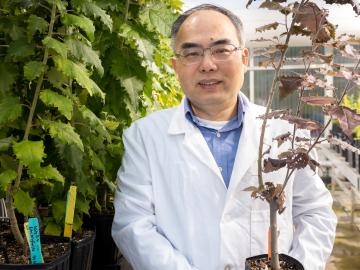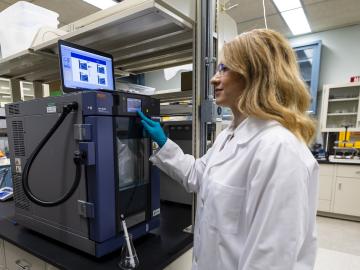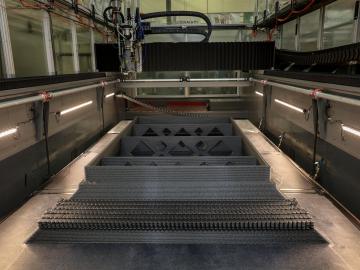
Filter News
Area of Research
- Advanced Manufacturing (2)
- Biological Systems (1)
- Biology and Environment (59)
- Building Technologies (1)
- Computational Engineering (1)
- Computer Science (2)
- Electricity and Smart Grid (1)
- Energy Science (68)
- Energy Sciences (1)
- Fuel Cycle Science and Technology (1)
- Fusion and Fission (21)
- Fusion Energy (5)
- Isotope Development and Production (1)
- Isotopes (17)
- Materials (79)
- Materials Characterization (2)
- Materials Under Extremes (1)
- National Security (29)
- Neutron Science (36)
- Nuclear Science and Technology (3)
- Supercomputing (80)
News Type
Date
News Topics
- 3-D Printing/Advanced Manufacturing (50)
- Advanced Reactors (8)
- Artificial Intelligence (71)
- Big Data (38)
- Bioenergy (38)
- Biology (51)
- Biomedical (20)
- Biotechnology (16)
- Buildings (43)
- Chemical Sciences (54)
- Clean Water (11)
- Composites (17)
- Computer Science (69)
- Coronavirus (4)
- Critical Materials (13)
- Cybersecurity (9)
- Education (5)
- Emergency (4)
- Energy Storage (36)
- Environment (81)
- Exascale Computing (40)
- Fossil Energy (6)
- Frontier (40)
- Fusion (21)
- Grid (32)
- High-Performance Computing (78)
- Hydropower (4)
- Irradiation (2)
- Isotopes (28)
- ITER (2)
- Machine Learning (38)
- Materials (83)
- Materials Science (42)
- Mathematics (9)
- Mercury (2)
- Microelectronics (4)
- Microscopy (11)
- Molten Salt (2)
- Nanotechnology (9)
- National Security (55)
- Neutron Science (55)
- Nuclear Energy (36)
- Partnerships (53)
- Physics (23)
- Polymers (9)
- Quantum Computing (32)
- Quantum Science (31)
- Security (11)
- Simulation (53)
- Software (1)
- Space Exploration (7)
- Statistics (3)
- Summit (23)
- Transportation (33)
Media Contacts

The Department of Energy’s Oak Ridge National Laboratory announced the establishment of the Center for AI Security Research, or CAISER, to address threats already present as governments and industries around the world adopt artificial intelligence and take advantage of the benefits it promises in data processing, operational efficiencies and decision-making.

For 25 years, scientists at Oak Ridge National Laboratory have used their broad expertise in human health risk assessment, ecology, radiation protection, toxicology and information management to develop widely used tools and data for the U.S. Environmental Protection Agency as part of the agency’s Superfund program.

In 2023, the National School on X-ray and Neutron Scattering, or NXS, marked its 25th year during its annual program, held August 6–18 at the Department of Energy’s Oak Ridge and Argonne National Laboratories.

The Spallation Neutron Source — already the world’s most powerful accelerator-based neutron source — will be on a planned hiatus through June 2024 as crews work to upgrade the facility. Much of the work — part of the facility’s Proton Power Upgrade project — will involve building a connector between the accelerator and the planned Second Target Station.

Scientist Xiaohan Yang’s research at the Department of Energy’s Oak Ridge National Laboratory focuses on transforming plants to make them better sources of renewable energy and carbon storage.

ORNL hosted its annual Smoky Mountains Computational Sciences and Engineering Conference in person for the first time since the COVID-19 pandemic.

As Frontier, the world’s first exascale supercomputer, was being assembled at the Oak Ridge Leadership Computing Facility in 2021, understanding its performance on mixed-precision calculations remained a difficult prospect.

The common sounds in the background of daily life – like a refrigerator’s hum, an air conditioner’s whoosh and a heat pump’s buzz – often go unnoticed. These noises, however, are the heartbeat of a healthy building and integral for comfort and convenience.

Oak Ridge National Laboratory researchers have conducted a comprehensive life cycle, cost and carbon emissions analysis on 3D-printed molds for precast concrete and determined the method is economically beneficial compared to conventional wood molds.

The Oak Ridge Leadership Computing Facility, a Department of Energy Office of Science user facility at ORNL, is pleased to announce a new allocation program for computing time on the IBM AC922 Summit supercomputer.


